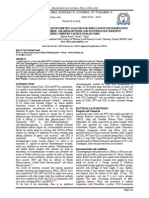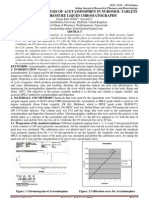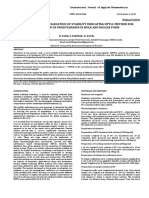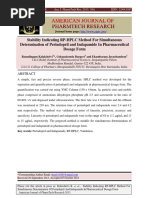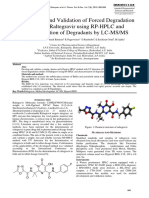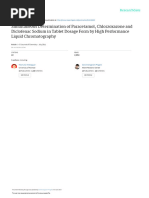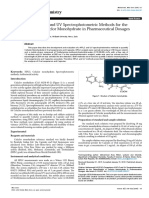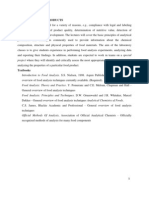3845-Article Text-10897-2-10-20200114
3845-Article Text-10897-2-10-20200114
Uploaded by
nhan phamCopyright:
Available Formats
3845-Article Text-10897-2-10-20200114
3845-Article Text-10897-2-10-20200114
Uploaded by
nhan phamCopyright
Available Formats
Share this document
Did you find this document useful?
Is this content inappropriate?
Copyright:
Available Formats
3845-Article Text-10897-2-10-20200114
3845-Article Text-10897-2-10-20200114
Uploaded by
nhan phamCopyright:
Available Formats
Balakrishna et al Journal of Drug Delivery & Therapeutics.
2020; 10(1):92-96
Available online on 15.01.2020 at http://jddtonline.info
Journal of Drug Delivery and Therapeutics
Open Access to Pharmaceutical and Medical Research
© 2011-18, publisher and licensee JDDT, This is an Open Access article which permits
unrestricted non-commercial use, provided the original work is properly cited
Open Access Research Article
Analytical method development and validation for the determination of
Brinzolamide by RP-HPLC
Tiwari Balakrishna 1*, Shirsat Mrunal K. 2, Kulkarni Amol 3
1 Research Scholar, Pacific University, Udaipur, India
2 Dean/Principal, PAHER University, Udaipur, India
3 Director, Institute of Pharmaceutical Science and Research (for girls), Swami Chincholi, Daund, Maharashtra, India
ABSTRACT
Brinzolamide is inhibitor of carbonic anhydride and is highly specific and non-competitive. The aim of the present study is to develop a simple,
precise, accurate, sensitive RP-HPLC method for the determination of bulk drug. The objective of the method validation is to demonstrate
whether the method was suited for the intended purpose. The method was validated as per the ICH guidelines. The method was validated for
linearity, precision (repeatability, intermediate precision), accuracy, specificity, robustness, ruggedness, limit of detection and limit of
quantification. Cosmosil (4.6X250mm, 5 μ) column was used for separation. The selected wavelength for Brinzolamide was 254 nm. The mobile
phase consists of Acetonitrile: Potassium dihydrogen phosphate buffer (40:60). Flow rate was delivered at 1.0 mL/min. Appropriate dilutions of
standard stock solutions were prepared to get desired concentrations in the range of 100-500 mcg/ml. The equation od standard curve was y =
441.8x + 1132 and R2 = 0.998. The RT obtained was 6.6167 minutes.
Keywords: Brinzolamide, UV spectroscopy, RP-HPLC, ICH
Article Info: Received 03 Nov 2019; Review Completed 21 Dec 2019; Accepted 29 Dec 2019; Available online 15 Jan 2020
Cite this article as:
Tiwari B, Shirsat MK, Kulkarni A, Analytical method development and validation for the determination of Brinzolamide by
RP-HPLC, Journal of Drug Delivery and Therapeutics. 2020; 10(1):92-96 http://dx.doi.org/10.22270/jddt.v10i1.3845
*Address for Correspondence:
Tiwari Balakrishna, Research Scholar, Pacific University, Udaipur, India
INTRODUCTION: After, doing in depth study in the present research work, it
was found that the present research work is having various
Brinzolamide is inhibitor of carbonic anhydride and is highly advantages over the previous work. The advantages include
specific and non-competitive. Chemically Brinzolamide is less retention times of the component, with good resolution.
(4R)-4-(ethylamino)-2-(3-methoxypropyl)-1,1-dioxo- The % RSD of robustness was found to be less. The results
2H,3H,4H-1λ⁶-thieno[3,2-e] [1,2]thiazine-6-sulfonamide. obtained from the validation suggest that the method was
Carbonic anhydrase is a type of enzyme that can be found in found to be precise, accurate, linear and robust enough and
several body tissues including eye. It is responsible for the method was also found to be economical.
catalysation of the reversible reaction indulged in carbon
dioxide hydration and carbonic acid dehydration. In human
beings, carbonic anhydrase is present in form of various
isoenzymes among which the most active one is carbonic
anhydrase II. During the ciliary processes of eye when
carbonic anhydrase is inhibited it results in reduction of
secretion of aqueous humour, most probably by decreasing
the creation of bicarbonate ions with further decrease in
transportation of sodium and fluid. This result in decrease of
intraocular pressure.
Literature review suggest few HPLC ,HPTLC, spectroscopic ,
Stability indicating HPLC determinations were performed.1-13 Figure 1: Sturucture of Brinzolamide
The aim of the present study is to develop a simple, precise,
accurate, sensitive HPLC method for the determination.
ISSN: 2250-1177 [92] CODEN (USA): JDDTAO
Balakrishna et al Journal of Drug Delivery & Therapeutics. 2020; 10(1):92-96
EXPERIMENTAL WORK: Validation procedure:
Chemicals and reagents: HPLC grade acetonitrile, The objective of the method validation is to demonstrate
methanol, from Spectro Chemie. Ammonium acetate, acetic whether the method was suited for the intended purpose.
acid of analytical grade was used. Millipore grade water was The method was validated as per the ICH guidelines. The
used. The reference standard samples of Brinzolamide was method was validated for linearity, precision (repeatability,
provided was provided by Ajanta Pharma. intermediate precision), accuracy, specificity, robustness,
ruggedness, limit of detection, limit of quantification. A
Instrumentation and analytical conditions: calibration graph was constructed by taking six different
The analysis was carried out by using Younglin (S.K) concentrations, ranging from 50 – 150 μg/mL. The peak area
Gradient System UV Detector, 4.6X250mm cosmosil column, was calculated, and calibration curve was constructed by
20ml loop size HPLC (With UV/Vis Detector. Other taking peak area and concentration on both the axis. The
instrumentation includes Double beam UV- Visible linearity was evaluated by linear regression analysis. The
spectrophotometer Simadzu UV-1800, digital balance precision studies were demonstrated by two parameters
(metler tolado), vacuum pump (Gelman science), pH meter inter day and intraday precision. Intraday precision was
(poloman). performed by injecting six replicated injections to the
chromatographic system on the same day and calculated the
Chromatographic conditions: %RSD. The inter day precision was performed by injecting
Cosmosil (4.6X250mm, 5 μ) column was used for separation. six replicated injections at two consecutive days. From the
peak area of the chromatograms, the %RSD was calculated.
Preparation of Standard stock solution: The accuracy was determined by adding a known amount of
the standard to the sample, and the percentage recovery was
100 mg of Brinzolamide was weighed in to 100 ml
estimated. The robustness was determined by incorporating
volumetric flasks. The drug was dissolved in 40 ml of solvent,
deliberate changes into the method conditions like the
and shaken manually for 10 min. The volume was made up to
change in flow rate, pH, and gradient. Ruggedness was
the mark with solvent and the final strength obtained was
performed by carrying out the proposed method with two
1000 µg/ml.
different analysts.
Preparation of sample solution:
RESULTS AND DISCUSSION:
1, 2, 3, 4, 5ml of the standard stock solution of Brinzolamide
were transferred separately into five 10ml volumetric flasks Selection of wavelength:
and volume was made up to mark to get the final UV spectrum was obtained by preparing a solution by taking
concentrations of 10, 20, 30, 40, 50µg/ml of Brinzolamide. diluents and scanned between 200 to 400 nm. Brinzolamide
The chromatograms were recorded and a standard curve shows λmax at 254 nm. So, it is selected as a detection
was plotted by taking concentrations on x-axis and area wavelength.
under curve on y-axis. The equation of standard curve was
generated to determine the concentration of drug in pure
and degradation products.
Figure 2: Spectrum of Brinzolamide
Development and optimization of the HPLC method: delivered at 1.0 mL/min with detection wavelength at 254
nm. A 20 μL was injected to the chromatographic system
For getting an optimized chromatographic condition, A
with ambient temperature. Acetonitrile: Potassium
Cosmosil (4.6X250mm, 5 μ) column was used for separation.
dihydrogen phosphate buffer (40:60) was the optimized
The mobile phase consists of Acetonitrile: Potassium
mobile phase selected for experimentation. The RT obtained
dihydrogen phosphate buffer (40:60). Flow rate was was 6.6167 minutes.
ISSN: 2250-1177 [93] CODEN (USA): JDDTAO
Balakrishna et al Journal of Drug Delivery & Therapeutics. 2020; 10(1):92-96
Figure 3: RT of Brinzolamide
Method validation: 500 mcg/ml. Then the concentrations were plotted against
the area under curves to get the equation of standard curve,
Linearity:
as presented in Table 1.
Appropriate dilutions of standard stock solutions were
prepared to get desired concentrations in the range of 100-
Table 1: Dilutions for linearity study
Stock solution Diluted (ml) Final
(µl) concentration
100 10 10
200 10 20
300 10 30
400 10 40
500 10 50
Figure 4: Standard curve of Brinzolamide
Table 2: Linearity Data
S. N. Conc. in (µg/ml) Mean AUC (n = 5) % RSD
1 10 5236 0.453
2 20 10113 0.243
3 30 14705 0.428
4 40 18999 0.651
5 50 22884 0.766
ISSN: 2250-1177 [94] CODEN (USA): JDDTAO
Balakrishna et al Journal of Drug Delivery & Therapeutics. 2020; 10(1):92-96
Precision:
Precision is determined at two levels: a) Repeatbility b) Intraday and Interday Precision.
Table 3: Precision Data
Parameter Amount taken (µg/ml) Amount found* (µg/ml) %RSD
System Precision 60 59.94 0.475
Method Precision 60 60.15 0.683
*Mean of Six observations
Table 4: Intraday and Interday Precision Data
Concentration of Brinzolamide Intraday* %RSD Interday * %RSD
20µg/ml 20.07 0.083 19.92 0.138
40µg/ml 39.99 0.091 39.94 0.129
60 µg/ml 60.09 0.074 59.91 0.144
*Mean of three observations
Accuracy:
To check the accuracy of the developed methods, analytical recovery experiment was carried out by standard addition method.
Recovery study was performed by adding 80, 100 and 120 % of the test concentration as per ICH guidelines.
Table 5: Accuracy
Concentration of Drug Concentration of Drug
Sr. No. % Recovery± SD
Added (µg/ml) Added (µg/ml)
1 64 10.4 99.99 ± 0.006
2 80 13 99.96 ± 0.018
3 96 15.6 96.95 ±0.027
Limit of Quantification (LOQ) and Limit of Detection Robustness was studied by observing the change in
(LOD): following parameters, and then observation of each
parameter change was done to access their effect on system
The limit of quantification (LOQ) is defined as the lower
suitability and assay. Change in mobile phase composition
concentration of an analyte in a sample that can be
was done by ± 5.0 ml of organic solvent and the change in
determined with acceptable precision and accuracy under the detection wavelength ± 10 nm was done.
the stated operational conditions of the method. The limit of
detection (LOD) is defined as the lowest concentration of an Change in mobile phase composition: The sample solution
analyte in a sample that can be detected, not quantified. The at test concentration (60μg/ml of drug was injected thrice
LOD and LOQ were estimated from the set of 5 calibration with the mobile phase composition changed by ± 5.0ml of
curves used to determine method linearity. The LOD and organic solvent from the developed method.
LOQ were calculated using following formula
Change in detection wavelength: The sample solution at
LOD = 3.3× σ/S test concentration (60μg/ml of drug was injected thrice with
the change in detection wavelength by ± 10 nm from the
LOQ= 10× σ/S
developed method. The % assay of drug after changes in
Where, σ = Standard deviation of the Y- intercepts of the 5 method parameters were observed.
calibration curves, S = Mean slope of the 5 calibration curves.
CONCLUSION:
The LOQ and LOD parameters of Brinzolamide are provided
A precise RP – HPLC method was developed for the
in Table 5.
determination of Brinzolamide. The shorter run time elutes
Table 6: LOD and LOQ parameters Erlotinib hydrochloride with good resolution, and
symmetry. The method was validated as per the ICH
Parameter Values guidelines and the method was found to be simple, precise,
S.D. of Intercept* 0.531037 linear, accurate, rugged and robust enough.
Mean Slope of Calibration Curve* 441.8
LOD (μg/ml) 0.00396
LOQ (μg/ml) 0.01202
Robustness:
ISSN: 2250-1177 [95] CODEN (USA): JDDTAO
Balakrishna et al Journal of Drug Delivery & Therapeutics. 2020; 10(1):92-96
Table 7: Summary of Validation parameters (5) Devi, C. M.; Kalita, P.; Dutta, R. S. Development and validation
of simple UV spectrophotometric method for estimation of
Parameters Brinzolamide brinzolamide. J. Pharm. Sci. Innov. 2019, 8 (2), 60–63.
https://doi.org/10.7897/2277-4572.02564.
Accuracy 98.95 ±0.427– 99.93 ± 0.226 (6) Vijya, P.; Patel, D.; Desai, S.; Meshram, D. Development and
Validation of Derivative Spectrophotometric Method for
Precision (%RSD) Simultaneous Estimation of Brimonidine Tartrate and
System Precision 0.475 Brinzolamide in Combined Dosage Form. Indo Am. J. Pharm.
Res. 2014, 4 (3), 1478.
Method Precision 0.683 (7) Anusha, B.; Geetha Susmita, A.; Rajitha, G. Analytical Method
Development and Validation of New RP-HPLC Method for
Intra-day (n = 3) 0.074 - 0.091 Simultaneous Estimation of Brinzolamide and Timolol
Maleate in Ophthalmic Solutions. Res. J. Pharm. Biol. Chem. Sci.
Inter-day (n = 3) 0.129 - 0.144 2016, 7 (3), 1290–1298.
(8) Manoharan, G.; Al-Bratty, M. Development and Validation of
LOD and LOQ Ultra Violet Spectrophotometric and Reversed-Phase High
Performance Liquid Chromatography Techniques for
LOD 0.00396
Simultaneous Estimation of Brinzolamide and Brimonidine
LOQ 0.01202 Tartrate in Ophthalmic Suspension Formulation. Orient. J.
Chem. 2016, 32 (2), 1111–1120.
https://doi.org/10.13005/ojc/320236.
(9) Agrawal, V. P.; Desai, S. S.; Jani, G. K. Development of RP-HPLC
REFERENCES: Method for Simultaneous Determination of Brimonidine
Tartrate and Brinzolamide by QbD Approach and Its
(1) Patel, S. Analytical Method Development and Validation of Validation. Eurasian J. Anal. Chem. 2016, 11 (2), 63–78.
Stability Indicating RP-HPLC Method for Estimation of https://doi.org/10.12973/ejac.2016.122a.
Amlodipine Besylate and Celecoxib in Synthetic Mixture. Int. J. (10) Kudumula, N.; Prasad Rajendra, Y. Development and
Adv. Res. 2019, 7 (3), 1066–1075. Validation of RP-HPLC Method for the Simultaneous
https://doi.org/10.21474/ijar01/8736. Estimation of Chlorthalidone and Cilnidipine in Bulk and
(2) Agrawal, V. P.; Desai, S. S.; Jani, G. K. Development of Combined Tablet Dosage Form. Pharmacophore 2014, 5 (4),
Ultraviolet Spectrophotometric Method for the Simultaneous 442–450.
Estimation of Brimonidine Tartrate and Brinzolamide. Indian (11) Foivas, A.; Malenović, A.; Kostić, N. Quantitation of
Drugs 2015, 52 (11), 29–34. Brinzolamide in Dried Blood Spots by a Novel LC-QTOF-
(3) Shah, P. A.; Kadikar, A. S.; Katira, R. M.; Patel, K. G.; Gandhi, T. MS/MS Method. J. Pharm. Biomed. Anal. 2016, 119, 84–90.
R. Simultaneous Determination of Brinzolamide and Timolol (12) Mashru, R.; Senta, B. Development and Validation of
Maleate Using Three Different Spectrophotometric Methods. Spectrophotometric Method for Simultaneous Estimation of
World J. Pharm. Pharm. 2014, 3 (2), 1955–1967. Brinzolamide and Brimonidine Tartrate. Asian J. Pharm. Life
(4) Eissa, M. S.; Nour, I. M.; Elghobashy, M. R.; Shehata, M. A.; Sci. 2014, 4 (2), 16–20.
Chemistry department, A.; City, B.; El-, K. Validated (13) Khatun, R.; Islam, S. Development and Validation of Analytical
Spectrophotometric Methods for Simultaneous Determination Method for Simultaneous Estimation of Brinzolamide and
of Brinzolamide and Timolol Maleate in Their Pure Form and Timolol by HPLC from Ophthalmic Preparation. Int. J. Pharm.
Ophthalmic Preparation. Al-Azhar J. Pharm. Sci. 2018, 54 (2), Sci. Res. 2014, 5 (3), 1001–1007.
188–202. https://doi.org/10.21608/ajps.2018.6643.
ISSN: 2250-1177 [96] CODEN (USA): JDDTAO
You might also like
- A Laboratory Manual of Physical PharmaceuticsFrom EverandA Laboratory Manual of Physical PharmaceuticsRating: 2.5 out of 5 stars2.5/5 (2)
- Meloan - Chemical Separations - Principles, Techniques and Experiments HQ (Wiley, 1999)Document767 pagesMeloan - Chemical Separations - Principles, Techniques and Experiments HQ (Wiley, 1999)Ajithkumar100% (1)
- Solubility Questions and AnswersDocument2 pagesSolubility Questions and AnswersBrittany100% (3)
- Stability Indicating RP-LC Assay Method For Carisoprodol: Original ArticleDocument7 pagesStability Indicating RP-LC Assay Method For Carisoprodol: Original ArticleNguyen binhNo ratings yet
- Estimation of Satranidazole in Bulk and Tablet Dosage Form by RP-HPLCDocument3 pagesEstimation of Satranidazole in Bulk and Tablet Dosage Form by RP-HPLCGautam GurjarNo ratings yet
- Development of HPLC Method For The Determination of Zinc Carnosine in Bulk and Dosage FormsDocument5 pagesDevelopment of HPLC Method For The Determination of Zinc Carnosine in Bulk and Dosage FormsSouheila MniNo ratings yet
- EDUSJ Volume27 Issue3 Pages19-35Document18 pagesEDUSJ Volume27 Issue3 Pages19-35Eyunike SitumorangNo ratings yet
- Development and Validation of A HPTLC Method For Rivaroxaban in Human Plasma For A Pharmacokinetic StudyDocument6 pagesDevelopment and Validation of A HPTLC Method For Rivaroxaban in Human Plasma For A Pharmacokinetic Studypramod aloorNo ratings yet
- ChlordiazepoxideHydrochlorideClidiniumBromide and PantprazoleDocument6 pagesChlordiazepoxideHydrochlorideClidiniumBromide and Pantprazoleiabureid7460No ratings yet
- An HPLC Method For The Estimation of AndrographoliDocument5 pagesAn HPLC Method For The Estimation of Andrographoliakurat LabNo ratings yet
- Nadifloxacin - HPTLC Stability Indicating PDFDocument8 pagesNadifloxacin - HPTLC Stability Indicating PDFNájla KassabNo ratings yet
- 11Document11 pages11PARTHKUMAR PRAJAPATINo ratings yet
- Mitijps PaperDocument7 pagesMitijps PaperBrijeshkunvar MishraNo ratings yet
- Validation of UV Spectrophotometric Method For Determination of AtenololDocument4 pagesValidation of UV Spectrophotometric Method For Determination of AtenololElfiaNeswitaNo ratings yet
- Development of LC Method For Estimation of Diethyl Carbamazine Citrate and Chlorpheniramine Maleate in Combined Dosage FormDocument8 pagesDevelopment of LC Method For Estimation of Diethyl Carbamazine Citrate and Chlorpheniramine Maleate in Combined Dosage FormWhulan MudiaNo ratings yet
- 4 RJPT 14-2-2021 Akshata ResearchDocument5 pages4 RJPT 14-2-2021 Akshata ResearchNutan Desai RaoNo ratings yet
- Jurnal HPLC KromatografiDocument8 pagesJurnal HPLC KromatografiDevi AtikahNo ratings yet
- 06 Iajps06092020Document7 pages06 Iajps06092020iajpsNo ratings yet
- Research Article: Received: 23 July 2016, Revised and Accepted: 30 September 2016Document7 pagesResearch Article: Received: 23 July 2016, Revised and Accepted: 30 September 2016AndreyNo ratings yet
- Development of Validated RP-HPLC Method For Determination of Sibutramine Applying QBD ApproachDocument4 pagesDevelopment of Validated RP-HPLC Method For Determination of Sibutramine Applying QBD ApproachInternational Journal of Innovative Science and Research TechnologyNo ratings yet
- Research Article: Spectrophotometric Methods For Estimation of Diclofenac Sodium in TabletsDocument6 pagesResearch Article: Spectrophotometric Methods For Estimation of Diclofenac Sodium in TabletswiracanaNo ratings yet
- Estabilidad de La IndometacinaDocument7 pagesEstabilidad de La IndometacinaJosé RojasNo ratings yet
- 4350-Article Text-12361-1-10-20170903Document4 pages4350-Article Text-12361-1-10-20170903nhan phamNo ratings yet
- Indian Journal of Research in Pharmacy and BiotechnologyDocument144 pagesIndian Journal of Research in Pharmacy and BiotechnologyDebjit Bhowmik0% (1)
- UV GlibenclamideDocument6 pagesUV GlibenclamideGeraldi CoolNo ratings yet
- Clindamicina +clotrimazolDocument5 pagesClindamicina +clotrimazolJEISSON FERNANDO CRUZ MENDOZANo ratings yet
- Trading PatternsDocument7 pagesTrading PatternsnatiforextraderNo ratings yet
- BisopDocument11 pagesBisopAlinaDianaNo ratings yet
- Development and Validation of Stability Indicating HPTLC Method For Estimation of Swertiamarin in Bulk and Dosage FormDocument5 pagesDevelopment and Validation of Stability Indicating HPTLC Method For Estimation of Swertiamarin in Bulk and Dosage Formshraddha5jNo ratings yet
- Carisoprodol Tablets Method ArticleDocument7 pagesCarisoprodol Tablets Method ArticleurvamehtaNo ratings yet
- Determination and Validation of Uv Spectrophotometric Method For Estimation of Bicalutamide TabletDocument5 pagesDetermination and Validation of Uv Spectrophotometric Method For Estimation of Bicalutamide TabletGembong Van BeethovenNo ratings yet
- 3972-Article Text-11394-2-10-20200418Document4 pages3972-Article Text-11394-2-10-20200418Shantanu MannaNo ratings yet
- 21 Vol. 9 Issue 7 July 2018 IJPSR RA 9344Document7 pages21 Vol. 9 Issue 7 July 2018 IJPSR RA 9344ChilaNo ratings yet
- Development and Validation of LC Method For The Estimation of Lincomycin in Pharmaceutical DosageformsDocument4 pagesDevelopment and Validation of LC Method For The Estimation of Lincomycin in Pharmaceutical DosageformsLam NguyễnNo ratings yet
- Stability-Indicating HPLC Assay For DeterminationDocument5 pagesStability-Indicating HPLC Assay For DeterminationshuyeeNo ratings yet
- Development and Validation of A ReversedDocument14 pagesDevelopment and Validation of A ReversedKarina Guadarrama HernándezNo ratings yet
- Spectrophotometric Methods For The Determination of Ketoconazole in Pharmaceutical Dosage FormsDocument4 pagesSpectrophotometric Methods For The Determination of Ketoconazole in Pharmaceutical Dosage FormsLulu ListianaNo ratings yet
- Stability Indicating Uvvis Spectrophotometric Method For Diazepam Development and Validation PDFDocument8 pagesStability Indicating Uvvis Spectrophotometric Method For Diazepam Development and Validation PDFSiti JihaNo ratings yet
- 1 s2.0 S1878535212001566 MainDocument5 pages1 s2.0 S1878535212001566 Mainnur azizahNo ratings yet
- Spectrophotometry IRDocument5 pagesSpectrophotometry IRSoffatul AzizahNo ratings yet
- Estimation of Meropenem in Human Plasma by HPLC-UV and Its Application in Comparative Bioavailability StudyDocument8 pagesEstimation of Meropenem in Human Plasma by HPLC-UV and Its Application in Comparative Bioavailability Studyayand2005No ratings yet
- Yuanping Wang Chuqin Yu: Preparation and in Vitro Dissolution of Curcumin Tablets,, Zhixiang Gan, Zhongbo XieDocument7 pagesYuanping Wang Chuqin Yu: Preparation and in Vitro Dissolution of Curcumin Tablets,, Zhixiang Gan, Zhongbo XieChristineNo ratings yet
- Development and Validation of RP-HPLC Method For Simultaneous Estimation of Ivermectin and Clorsulon in Ivercam InjectionDocument9 pagesDevelopment and Validation of RP-HPLC Method For Simultaneous Estimation of Ivermectin and Clorsulon in Ivercam InjectionFaelFernandesNo ratings yet
- Method Development Anda Validation HLPC DithranolDocument6 pagesMethod Development Anda Validation HLPC DithranolTiago GonçalvesNo ratings yet
- 16.publication PaperDocument16 pages16.publication PaperBaru Chandrasekhar RaoNo ratings yet
- Stability Indicating Uvvis Spectrophotometric Method For Diazepam Development and ValidationDocument8 pagesStability Indicating Uvvis Spectrophotometric Method For Diazepam Development and ValidationElena DoniciNo ratings yet
- Neomycin HPLCDocument7 pagesNeomycin HPLChang.oscar97No ratings yet
- Stability Indicating RP-HPLC Method For Simultaneous Determination of Perindopril and Indapamide in Pharmaceutical Dosage FormDocument9 pagesStability Indicating RP-HPLC Method For Simultaneous Determination of Perindopril and Indapamide in Pharmaceutical Dosage FormBoovizhikannan ThangabalanNo ratings yet
- ClosantelDocument6 pagesClosantelLaOde AdinNo ratings yet
- Development and Validation of RP-HPLC Method For Quantitative Estimation of Indapamide in Bulk and Pharmaceutical Dosage FormsDocument6 pagesDevelopment and Validation of RP-HPLC Method For Quantitative Estimation of Indapamide in Bulk and Pharmaceutical Dosage FormsAlexandru GondorNo ratings yet
- Martins 2019Document7 pagesMartins 2019Hasna NoerNo ratings yet
- Jps R 07091513Document5 pagesJps R 07091513Ahmed SuhailNo ratings yet
- UV Spectrophotometeric Analytical Method Development and Validation For The Determination of Telmisartan in Pharmaceutical Drug and Drug Formulation Tablet Dosage FormDocument6 pagesUV Spectrophotometeric Analytical Method Development and Validation For The Determination of Telmisartan in Pharmaceutical Drug and Drug Formulation Tablet Dosage FormEditor IJTSRDNo ratings yet
- 1129 PDFDocument3 pages1129 PDFDrVenu Madhav KNo ratings yet
- IbandronateDocument6 pagesIbandronateAashishThakurNo ratings yet
- J Jtusci 2014 06 001Document7 pagesJ Jtusci 2014 06 001Mohamed Medhat AliNo ratings yet
- Admin, Journal Manager, 24199-118524-1-CEDocument5 pagesAdmin, Journal Manager, 24199-118524-1-CESachin BagewadiNo ratings yet
- Jurnal Metformin HCLDocument4 pagesJurnal Metformin HCLWilliam SmithNo ratings yet
- Simultaneous Determination of Paracetamol ChlorzoxDocument7 pagesSimultaneous Determination of Paracetamol ChlorzoxVijendra ChauhanNo ratings yet
- Tujan ProjDocument4 pagesTujan ProjMayson BaliNo ratings yet
- 3 Component Valsartan CHZ AmyloDocument5 pages3 Component Valsartan CHZ Amyloabdelaziz_ismail685662No ratings yet
- Practical Handbook of Pharmaceutical Chemistry for M.PharmFrom EverandPractical Handbook of Pharmaceutical Chemistry for M.PharmNo ratings yet
- 12 Spectroscopic Method For Determination of Desloratadine PDFDocument4 pages12 Spectroscopic Method For Determination of Desloratadine PDFnhan phamNo ratings yet
- Fulltext - Ajapc v3 Id1062Document6 pagesFulltext - Ajapc v3 Id1062nhan phamNo ratings yet
- Farmacia Materias Activos en 161Document1 pageFarmacia Materias Activos en 161nhan phamNo ratings yet
- Polish Journal of Chemical Technology - 1 - 2016 - LubczakDocument7 pagesPolish Journal of Chemical Technology - 1 - 2016 - Lubczaknhan phamNo ratings yet
- Voltammetric Oxidation of Ambroxol and ADocument5 pagesVoltammetric Oxidation of Ambroxol and Anhan phamNo ratings yet
- Rifampicin, Isoniazid and Ethambutol TabletsDocument3 pagesRifampicin, Isoniazid and Ethambutol Tabletsnhan phamNo ratings yet
- 0002 - Complete Monograph Methods - Esomeprazole - MMDocument29 pages0002 - Complete Monograph Methods - Esomeprazole - MMnhan phamNo ratings yet
- UV and IR Spectra Pharmaceutical Substances (UV and IR) and Pharmaceutical and Cosmetic Excipients (IR)Document1 pageUV and IR Spectra Pharmaceutical Substances (UV and IR) and Pharmaceutical and Cosmetic Excipients (IR)nhan phamNo ratings yet
- 4350-Article Text-12361-1-10-20170903Document4 pages4350-Article Text-12361-1-10-20170903nhan phamNo ratings yet
- Estimation of Levocetirizine in Bulk and Formulation by First Order Derivative Area Under Curve UV-Spectrophotometric MethodsDocument7 pagesEstimation of Levocetirizine in Bulk and Formulation by First Order Derivative Area Under Curve UV-Spectrophotometric Methodsnhan phamNo ratings yet
- IP 2010 Sildenafil TabletsDocument2 pagesIP 2010 Sildenafil Tabletsnhan phamNo ratings yet
- Spectro Uorimetric Determination of Sildenafil: A New Analytical Alternative For Its AnalysisDocument8 pagesSpectro Uorimetric Determination of Sildenafil: A New Analytical Alternative For Its Analysisnhan phamNo ratings yet
- Effects of Omega-3 Co-Administered With Therapeutic Dose of Lornoxicam On Male Rats' LiverDocument6 pagesEffects of Omega-3 Co-Administered With Therapeutic Dose of Lornoxicam On Male Rats' Livernhan phamNo ratings yet
- Influence of Some Starch Binders On The Brittle FRDocument5 pagesInfluence of Some Starch Binders On The Brittle FRnhan phamNo ratings yet
- Crystal Structures and Crystal GeometryDocument44 pagesCrystal Structures and Crystal GeometryAdmiirall Ahmad Iero Part IINo ratings yet
- Using of SPME in Sample Preparation For Doping AnalysisDocument12 pagesUsing of SPME in Sample Preparation For Doping Analysiskassim AliNo ratings yet
- Analysis and Fate of Surfactants in The Aquatic EnvironmentDocument995 pagesAnalysis and Fate of Surfactants in The Aquatic EnvironmentCuauhtemoc de DiosNo ratings yet
- Question BankDocument9 pagesQuestion Bank21SMB37 Sheik Abdul Kadir. ANo ratings yet
- Tutorial 7-Chemical Equilibrium and Ionic Equilibria Part IDocument2 pagesTutorial 7-Chemical Equilibrium and Ionic Equilibria Part IRazy NicholaiNo ratings yet
- Buan GCFID MethodvalidationDocument6 pagesBuan GCFID MethodvalidationNora BuanNo ratings yet
- Complexometric TitrationDocument64 pagesComplexometric TitrationToyeba RahiNo ratings yet
- Gujarat Technological UniversityDocument2 pagesGujarat Technological UniversityKinnari PatelNo ratings yet
- A27 - Cetamine FB Calibration Data - 2020 03 20Document6 pagesA27 - Cetamine FB Calibration Data - 2020 03 20babaevdmitriNo ratings yet
- ASSAY PPT-MDDocument19 pagesASSAY PPT-MDMadiya Khan100% (1)
- PE I Paper 1 CMA SM PDFDocument4 pagesPE I Paper 1 CMA SM PDFvictorNo ratings yet
- Analysis of Maltose and Lactose by U-HPLC-ESI-MS-MSDocument21 pagesAnalysis of Maltose and Lactose by U-HPLC-ESI-MS-MSRaissaNo ratings yet
- Tarea DestilacionDocument12 pagesTarea DestilacionAnyy Ocon TtitoNo ratings yet
- Calculation MiselDocument4 pagesCalculation MiselSholeh KNo ratings yet
- Mcqs For Mock TestDocument7 pagesMcqs For Mock TestkkjhNo ratings yet
- Chapter 7: Acid and Bases: Chemistry A+ Agathum, U Can DO IT!!!!Document42 pagesChapter 7: Acid and Bases: Chemistry A+ Agathum, U Can DO IT!!!!NurNo ratings yet
- Analytical Separation MethodDocument2 pagesAnalytical Separation MethodNajmin RoslanNo ratings yet
- Analysis of An Acid-Base Titration Curve: The Gran PlotDocument5 pagesAnalysis of An Acid-Base Titration Curve: The Gran Plotamila_vithanageNo ratings yet
- Atq E5Document2 pagesAtq E5BuiHopeNo ratings yet
- Chapter 8 Chemical Equilibrium Short Question With AnswersDocument6 pagesChapter 8 Chemical Equilibrium Short Question With AnswersshahidkakaNo ratings yet
- Fusion InternshipDocument35 pagesFusion InternshipVivek PrajapatiNo ratings yet
- Analysis of Food ProductsDocument114 pagesAnalysis of Food ProductsDrGajanan Vaishnav50% (2)
- Paper ChromatographyDocument6 pagesPaper ChromatographyfelescosorheaNo ratings yet
- Practical SDS PAGEDocument4 pagesPractical SDS PAGEaryanyadav72003No ratings yet
- Validated RP HPLC Method For Determining The Levels of BromhexineDocument9 pagesValidated RP HPLC Method For Determining The Levels of Bromhexinefoaad foaadNo ratings yet
- Certificate of Accreditation: Perry Johnson Laboratory Accreditation, IncDocument3 pagesCertificate of Accreditation: Perry Johnson Laboratory Accreditation, Inc分析室信箱No ratings yet
- Amazon Trapcontrol Training DocumentDocument24 pagesAmazon Trapcontrol Training DocumentxlkoNo ratings yet
- Protein Purification Using AKTA - SOPDocument4 pagesProtein Purification Using AKTA - SOPlatamudariNo ratings yet








